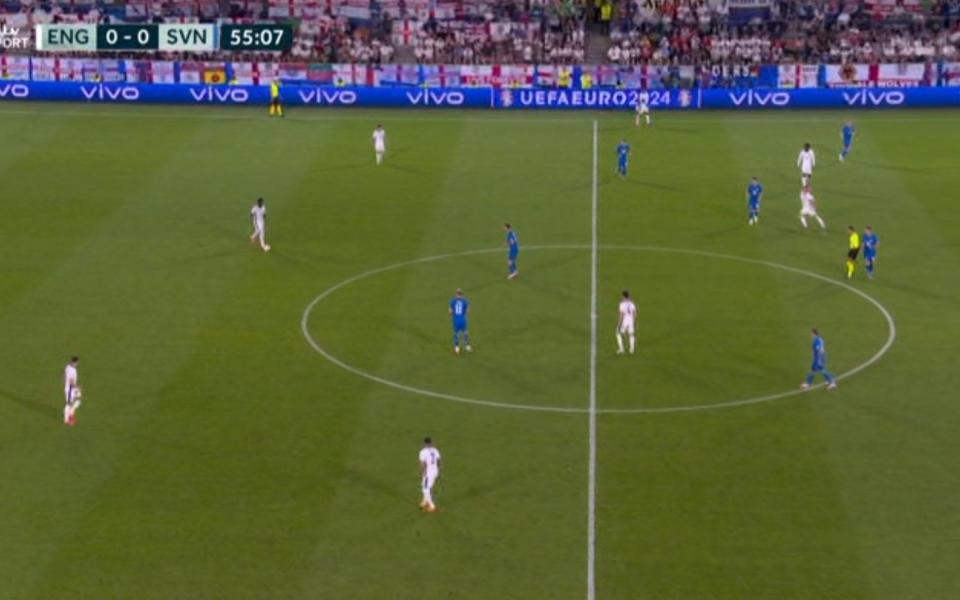The damning stat that proves England’s attacking play is slowest at Euro 2024

Keeping possession in tournament football has been a struggle for England across decades, but against Slovenia it was a case of possession without progression.
England supporters sat through long spells of sterile domination in Cologne, watching their team amass more than 70 per cent possession without seriously troubling goalkeeper Jan Oblak.
England’s performance looked like an unconvincing Manchester City impression, circulating the ball from side to side at a slow, deliberate tempo but without City’s final-third gear changes.
After England’s three group games, no team at Euro 2024 have attacked at a slower pace, according to Stats Perform’s direct speed metric. This measures the average speed at which the ball is progressed upfield in open-play sequences.
With an average direct speed of 1.24 metres per second, England are ranked 24th of 24 nations. That direct speed is also slower than any of the 20 teams who played in the Premier League last season.

This partly explains why so many long-suffering England fans have complained of their matches having a turgid, soporific feel in a tournament that has produced much entertainment. England have sucked the life out of games.
However, this is where the question of how quickly a team should attack becomes more complex. Pep Guardiola’s City were the slowest attack in the Premier League last season, when they won their fourth consecutive league title. They suffocate opponents and bring matches to a standstill, and it is a recipe for relentless success and peerless consistency.
Whether England should seek to emulate such a style with their profile of players is an open question, but their direct speed figure is slower than even City’s last season. City have better midfield passers and more pace in their forward line.

A team with aspirations of winning a tournament should not necessarily be the most direct, as shown by the presence of teams such as Poland, Georgia and Czech Republic at the top of the direct-speed rankings. These are sides who are forced to bunker their defence deep and play long.
Nevertheless, England need to find a better balance between control and creativity, which might nudge their direct speed up into the region of Spain, Portugal and Germany. So, why has England’s build-up play been so stodgy?
Too many bodies behind the ball
Slovenia sat off in a 4-4-2 defensive shape, against which England built play in a 4-1 shape with the back four spread across the pitch and Declan Rice in front. Occasionally, Conor Gallagher would drop deep to make this structure more of a 4-2. Much like against Denmark, did England need five or six players, plus Jordan Pickford, to play out against a circumspect Slovenia? In the below image, just in front of “Euro 2024”, Bellingham is in the position you would expect a left-back to advance into. Walker and Trippier are very conservative in their positions.

England’s attackers were outnumbered higher up the pitch, and England struggled to draw Slovenia’s central midfielders out. With a more attacking full-back advancing into the final third, such as Luke Shaw, England could turn their back four into a three, with Rice and a partner in front in a 3-2. Alternatively, England could look at pushing John Stones up a line alongside Rice, as he used to do alongside Rodri. Pushing things up one line would ask different questions of the opposition.
Lack of movement in forward line
Distribution is only one half of the story when it comes to ball progression. Passers need targets to hit and a team need players who move to receive the ball in threatening positions. Throughout the tournament, there has been a lack of mobility and off-ball running in England’s attack. Bukayo Saka was England’s best outlet in the first two games, but was starved of service against Slovenia as England’s attack tilted left. Harry Kane continues to look off the pace, and there are no stretching forwards, such as Raheem Sterling and Marcus Rashford, who dovetailed well with Kane previously. This is why the case for Anthony Gordon is growing stronger.
Midfielders not comfortable on the interior
In the first two games, England went with Alexander-Arnold and Rice, two players who do much of their best work for Liverpool and Arsenal receiving the ball outside of the opposition’s shape. They do this by pulling wide or dropping into the back line. One way to open up a deep defence is to have players happy receiving in tight spaces who can commit opponents. Gallagher offered no on-ball presence. Jude Bellingham and Phil Foden can, but are taking turns to do the graveyard shift wide left. Kobbie Mainoo excels at receiving the ball in these crowded scenes.
Possession as a defensive tactic
The perceived wisdom before the tournament was that England’s defence would be their downfall. While England’s players insist their intention is to play expressive, attacking football, are they using heaps of possession as a defensive tactic? Hiding the ball from opponents is an effective protection strategy, as City demonstrate. England currently look like a team who fear the consequences of losing the ball.

 Yahoo Sport
Yahoo Sport 






































